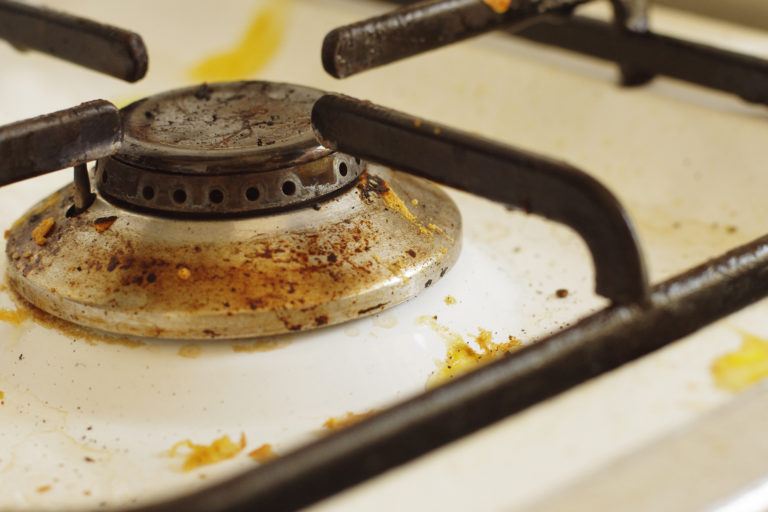
Quick Tips
You don’t have to be a five-star chef to coat your kitchen in a layer of grease. One pan-seared steak, one batch of bacon, one overly enthusiastic stir-fry session—suddenly, everything from your stove to your cabinets is coated in a sticky, grimy film. And the worst part? Grease doesn’t just wipe away like dust. It clings, congeals, and waits for you to give up.
Let it sit too long, and you’ll need more than a quick wipe-down to reclaim your kitchen. The good news? You don’t need heavy-duty chemicals or hours of scrubbing to get rid of built-up grease. You just need the right approach.
What You’ll Need to Cut Through the Grease
Before you start, gather the right supplies. Grease is stubborn, but with a few basic ingredients, you can break it down and wipe it away with minimal effort.
Essential Cleaning Supplies
- Small bucket or large bowl – For mixing your cleaning solution.
- Large bucket – For rinsing.
- Sponge – Non-abrasive, so you don’t damage surfaces.
- Microfiber cloths or cleaning rags – Soft and absorbent.
- Towels – To catch drips and dry surfaces afterward.
- Mild dish soap – The secret weapon against oil and grease.
- White vinegar – Removes residue and helps cut through grease.
Optional (For Stubborn Grease Buildup)
- Baking soda – Works as a gentle abrasive.
- Lemon juice – A natural degreaser.
- Citrus-based cleaner – Effective but should be tested on surfaces first.
- Commercial degreaser – For extreme buildup (eco-friendly options listed below).
Step 1: Prep Your Kitchen for Cleaning
Before you start scrubbing, take a few minutes to set up:
- Clear the area – Move small appliances, cutting boards, or utensils.
- Remove stove grates and burner plates – If they’re greasy, soak them in hot, soapy water.
- Take off cabinet handles – Grease loves to collect around hardware, so soak these in warm, soapy water.
- Lay down towels – Protect your floors from drips and excess water.
Step 2: Make a Powerful, Non-Toxic Degreasing Solution
Forget store-bought degreasers—you only need two ingredients to cut through kitchen grease.
- Soapy Water: In your small bucket, mix two pints of hot water with two tablespoons of dish soap.
- Vinegar Rinse: In a separate large bucket, mix one cup of white vinegar with 1 to 1.5 gallons of warm water.
Soap breaks down grease, while vinegar removes residue and adds shine. Yes, vinegar smells, but it dissipates quickly—and it’s a powerhouse against grease.
Step 3: Scrub the Grease Away
Now comes the fun part.
- Dip your sponge in the soapy water and wring it out slightly.
- Start scrubbing in circular motions, focusing on greasy spots.
- For heavy buildup, let the soapy water sit for a couple of minutes before scrubbing again.
- For extra stubborn grease, sprinkle baking soda on the sponge before scrubbing.
For tight spaces (like the gaps between your stove and countertop), wrap a damp cloth around a butter knife and use it to scrape away hidden grease.
Step 4: Rinse Everything with Vinegar Water
Once the grease is gone, you need to remove the soapy residue—otherwise, it can leave a film that attracts more dirt.
- Dip a clean cloth into the vinegar solution and wipe down all surfaces.
- Rinse the cloth frequently to avoid spreading grease.
- For large areas, swap out dirty rags for fresh ones.
Step 5: Do a Final Rinse with Clean Water
Now that everything is degreased, it’s time for one last wipe-down.
- Dump the vinegar water and refill the bucket with clean, warm water.
- Use a fresh cloth to wipe away any lingering soap or vinegar.
- Dry the area with a towel to prevent streaks.
Soap and vinegar both leave behind residues if not fully removed, so don’t skip this step.
Step 6: Dry Everything Completely
Use a clean, dry towel to absorb any leftover moisture. Pay extra attention to cracks and crevices where water might hide.
- If you removed cabinet handles, make sure they’re dry before putting them back.
- If you soaked burner plates, rinse, dry, and reassemble your stove.
- Check the floor – If you placed towels down, swap them out for dry ones to avoid slips.
Alternative Methods for Stubborn Grease
If you don’t have dish soap and vinegar, or you need extra power, try one of these alternatives:
Baking Soda Scrub
- Mix baking soda with warm water to form a paste.
- Apply to greasy areas and let sit for a few minutes.
- Scrub with a damp sponge and rinse.
Lemon or Orange Cleaner
- Citrus-based cleaners are great for cutting through grease.
- Rub a cut lemon over greasy spots or use a citrus-based degreaser.
- Wipe clean with a damp cloth.
- Note: Citrus can damage natural stone, so test it first.
Steam Cleaning
- If you have a handheld steam cleaner, use it to loosen tough grease before wiping.
Best Green Commercial Degreasers
If you need a heavy-duty degreaser but don’t want harsh chemicals, try these:
- Mean Green Cleaner & Degreaser – A biodegradable, non-toxic cleaner strong enough for tough grease.
- Simple Green All-Purpose Cleaner – Safe for most surfaces, great for daily maintenance.
- Green Works Multi-Surface Cleaner – Plant-based and powerful against kitchen grease.
All three are safer for you and the environment than traditional degreasers.
Final Thoughts
Cleaning kitchen grease isn’t difficult, but it takes the right approach. Regular maintenance—like wiping down surfaces after cooking—can prevent buildup and make deep cleaning a breeze.
With a simple soap-and-vinegar solution, some scrubbing, and a little patience, your kitchen can be grease-free and sparkling again. And best of all? You don’t need toxic chemicals to make it happen.